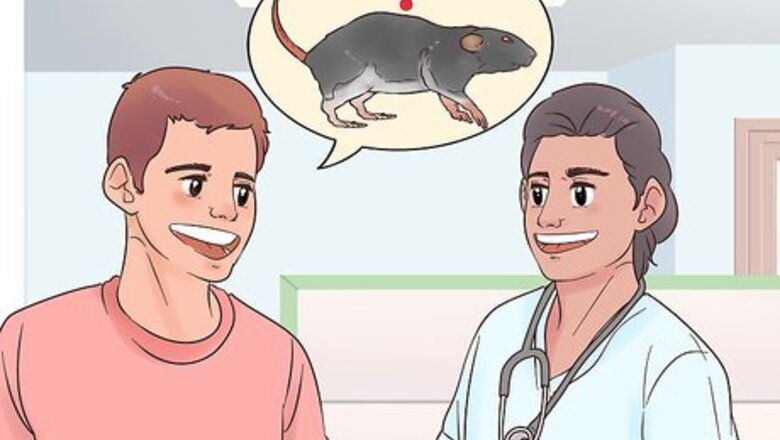
views
X
Research source
Acquiring Dumbo Rats

Choose a responsible, knowledgeable rat breeder. To identify potential breeders in your area, search the websites of breeding organizations and seek the opinions of local vets and friends with pet rodents. Once you've identified potential breeders, visit their operations and observe for yourself how the rats are cared for. Make sure the conditions are sanitary and humane, and that the rats appear healthy and content. Like any other pet, a rat adopted from a responsible source is more likely to be healthy and happy. It’s preferable not to buy rats from a pet store. You’ll have no idea about how they were birthed or raised, or their ancestry.
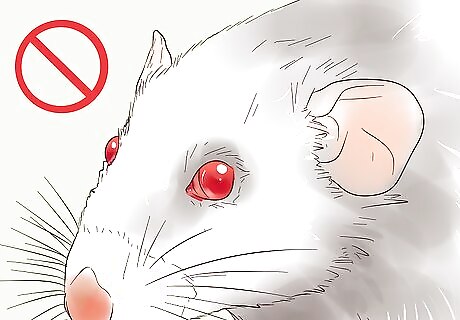
Avoid rats that show common signs of illness. Rats are susceptible to a range of respiratory illnesses, as well as cancerous and non-cancerous tumors. Before adopting one, look for visible signs of illness such as: reddish discharge from the eyes or nose heavy or noisy breathing cloudy or dull eyes liquid feces (instead of small pellets) lethargy, extreme shyness, or signs of wounds, which can indicate poor breeding conditions
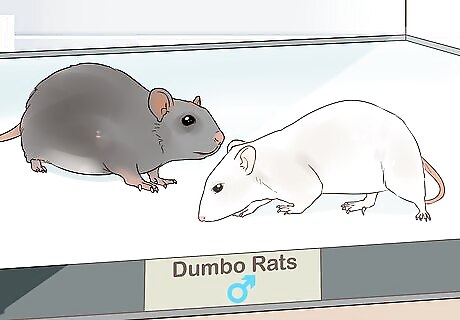
Plan to get at least 2 rats, typically of the same gender. As any homeowner with an unwanted infestation can attest, rats are social animals that like to live in groups. If you adopt only 1 rat, they will likely be lonely and depressed, which makes them less engaging and more susceptible to illness. The simplest option is to get 2 rats of the same gender. Females tend to be more friendly in general. If you get both male and female rats, make sure they have been spayed and neutered—unless you are prepared to begin a prolific breeding operation!
Housing Dumbos in a Cage
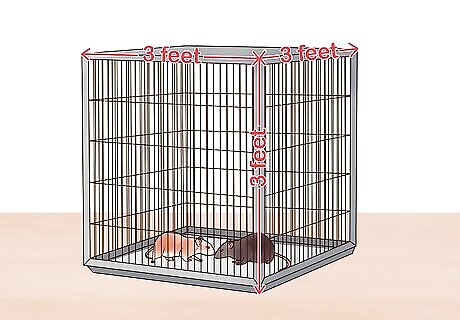
Provide at least 2 cubic feet (0.057 m) of cage space per rat. Dumbo rats can grow to 15–22 inches (38–56 cm) in length (including their tail), so they need ample space to maneuver. If their living quarters are too cramped, they’ll be anxious, bored, unhappy, and probably unhealthy. Since you should have at least 2 rats, you minimum cage size should be 4 cubic feet (0.11 m). But bigger is always better. Rats like taller cages with multiple levels to climb up and down on, so you might look for a 3 × 3 × 3 ft (0.91 × 0.91 × 0.91 m) square cage for 2 rats.
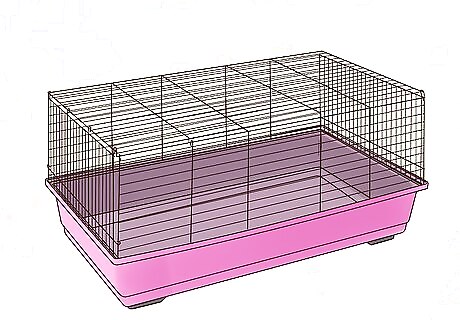
Use a cage with a flat floor, small openings, and a secure door. Rats can squeeze through surprisingly small openings, but a wire cage is still preferable to a glass enclosure because of the increased airflow. Look for a cage designed for rats in particular. Cages intended for rats will have the appropriate-sized openings, and doors that latch securely to keep rats from pushing them open. A rat cage should have a flat floor—one made of hard plastic, for instance—instead of a wire bottom. Otherwise, your rats may develop a serious foot condition known as “bumblefoot.”
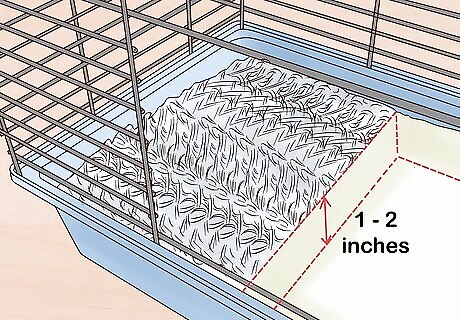
Layer the floor of the cage with 1–2 inches (2.5–5.1 cm) of bedding material. Use shredded cloth, shredded paper, or shredded hemp for bedding. However, avoid wood chips because they may cause respiratory problems. Plan to change this bedding regularly—weekly at the very least, when you deep clean the cage.

Add chew blocks, toys, and activity elements to the cage. Provide a constant supply of untreated wood blocks for use as chew toys, and add places to play and hide as well. Try ramps, tunnels, caves, ladders, and other pieces to keep your rats entertained. Check pet supply stores for toys and cage elements intended for rodents. Bored rats are not happy rats, so make sure you give them things to do in their cage!
Feeding and Caring for Dumbo Rats

Feed rats lab blocks, grain mix, and limited fresh produce. Look for lab blocks (which are basically extra-large food pellets) that are produced specifically for rats. These blocks will make up the majority of the rat’s diet. Each rat should eat about 0.5–0.75 ounces (14–21 g) of lab blocks per day. In addition, you can include a small amount of grain mix as well. You can also offer up to 1 tablespoon of fresh fruits and vegetables per day, per rat. Don’t give rats citrus, corn, or alfalfa, though. If possible, feed them in the evening (rats are nocturnal) and clean up any leftover food the next morning. Rats should have access to a dish of clean, fresh water at all times.
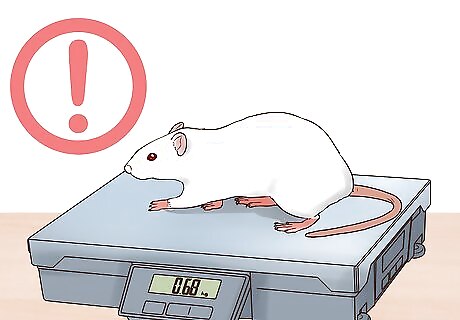
Watch for signs of overfeeding and obesity. Rats are omnivores that will readily overeat if given the chance. If your rat weighs noticeably more than 1.5 pounds (0.68 kg), looks paunchy, or has become lethargic, there is a decent chance that it is overweight. If there is leftover food in the morning after you feed them in the evening, try cutting back on the amount you give. Look for hidden stashes of uneaten food when you clean the cage.
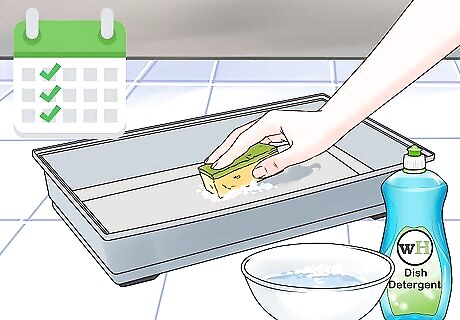
Clean the cage with soap and water at least once a week. Whenever the cage develops a noticeable odor, but at least one per week regardless, take everything out of the cage and discard the bedding material. Wipe all surfaces of the cage, and all the objects you temporarily remove from the cage, with a rag and warm, soapy water—dish soap is fine. Bleach and other harsh cleaning products can cause respiratory problems in rats. Rat urine contains a lot of ammonia. If the cage smells like ammonia, it’s time to clean it. Use a spare cage or enclosure while you clean the main cage, or keep the rat in a room that it can’t escape from or hide in.
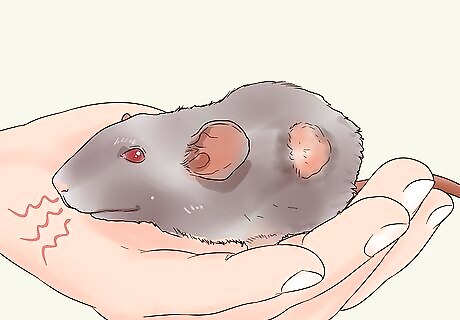
Look for signs of respiratory illnesses or tumors. Even if you provide the proper foods, use the right kind of bedding, and avoid harsh cleaners, your rat will still be prone to respiratory problems. Likewise, cancer is common in rats, as are non-cancerous tumors. If your rat has labored or noisy breathing and is lethargic, suspect a respiratory problem. Lethargy, reduced appetite, and lumps on the body could be signs of a cancerous or non-cancerous tumor.

Take your rats to a small animal vet for regular checkups. Any vet can provide care for a pet rat, but look for one with specialization in dealing with small animals like rodents. They’ll be more likely to spot any health problems early. Take your rat for a checkup at least once per year, or whenever you suspect a problem. With proper care and good luck in the health department, pet rats can live for up to 4 years. Expect to pay around $300 USD in total care costs (food, toys, vet care, etc.) during each year of a single rat’s life.
Socializing and Training Dumbos
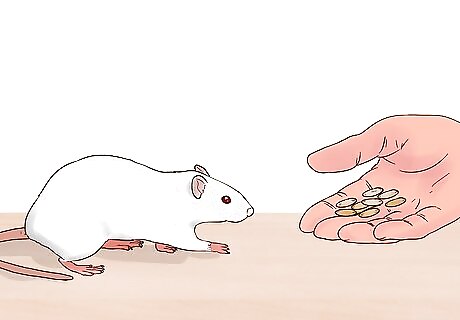
Use treats to familiarize a new rat with you before handling it. Dumbo rats are bred to be generally more friendly and sociable than other rats, but even they tend to be a little shy and skittish at first. Don’t just grab hold of a rat as soon as you bring it home. Instead, hold a small treat in your palm and allow the rat to approach and take it. After a few tries, move the treat deeper on your palm so the rat has to climb onto your hand to get it. Within a day or two, the rat will probably allow you to lift it in your hand. Use shelled sunflower seeds or Rice Krispies as rat treats.
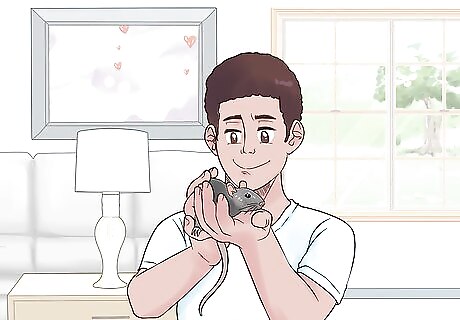
Handle rats carefully and supervise others who handle them. If you need to pick a rat up, grasp it around its body just behind the shoulders. Never pick it up by its tail. Cup your hand(s) over the rat to secure it in place, but don’t squeeze too hard. Make sure other people pick up and hold your rat properly as well. Pay special attention to children, who may unintentionally grasp or hold a rat too tightly. Once a rat is comfortable with you, it will probably climb right onto your open hand, and may scurry up to your shoulder!
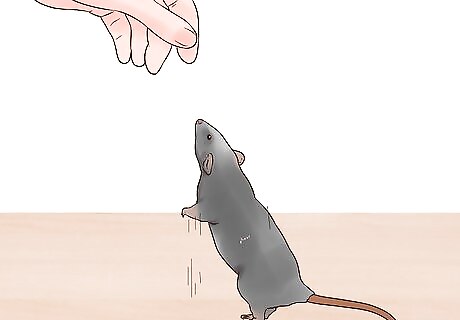
Train them to do tricks with sunflower seeds or Rice Krispies. Train your rat in a quiet, escape-proof room in 10-15 minute sessions, once or twice per day. Use the treat to guide them to do the requested trick—coming to you when called, standing, clapping their hands, jumping through hoops, etc.—and offer lots of verbal praise and affection during the process. For instance, to teach them to stand: hold the treat in front of the rat, say "stand" and raise the treat up as the rat sniffs it. As soon as the rat stands up to reach the treat, give them the treat and offer lots of praise. Eventually, you should be able to direct them to do the trick without the treat—your praise and affection will be enough of a reward!


















Comments
0 comment